The pervasive, efficient, all-encompassing Cloud is fast becoming THE chosen method of computing for major and minor enterprises everywhere. That’s a grand leap from starting out as a tech-fad which was almost instantly dismissed by many critics, proving just how wrong they all were.

The term itself is pretty descriptive, but you should have a thorough understanding of it nonetheless, especially if you’re considering switching to cloud-computing. Essentially, a network of remote servers will take the responsibility of storing, managing, and processing your data right off your shoulders. All of this will be taken care of by the provider, and the elements which will actually do the storing/managing/processing will do so behind the scenes; Invisible and inconspicuous.
The entire technology has dramatically altered IT. It allows businesses and users to focus on their key enterprises instead of wasting time and far-too-many resources to deal with IT issues. Which is why, for the foreseeable future, it is here to stay.
But there’s no perfect solution. Like everything, Cloud Computing comes with its own set of catches. It’s your job to consider both sides of the coin.

The Benefits
Make no mistake; Cloud has enormous benefits for everyone concerned because it is:
Economical
This is the most significant of all its advantages. Enterprises can save considerable sums with cloud which would otherwise be directed at software licensing and updates, data storage devices, server infrastructure management, and more.
You start out with a standard cost, which is pretty economic itself to begin with. As your business (and subsequently, your data and IT-need) grows, you can scale up by paying additional fees. That way, you pay for what you need. Other payment options like one-time or per-minute billing make cloud even more cost-effective and pocket-friendly.
Convenient and Accessible
You can practically access your data from the ends of the Earth (provided you have an internet connection).
Clouds go a step further to erase geographical boundaries. Users get round-the-clock access to information and data, no matter where they happen to be. As an end result, collaborative efforts across different countries and time zones are no longer hindered by restrictions on file transfers or time zones.
Cross-Platform Compatible
Any device that can be used to access the internet can access the cloud. Can’t wait for Project Glass to finish fine-tuning now?
Device compatibility issues become a thing of the past with cloud computing. The end-user decides which device to use, and where to use it from, and the cloud will accommodate it. This cuts down IT costs even further and takes a load (and maybe a job) off the guy who had to make sure every system for every employer had the same version of OS, browser, and set of apps installed.
Resilient
After Amazon’s cloud collapse debacle, most cloud service providers and users learned how redundancy is a very good thing when it comes to making cloud resilient.
Most cloud services have multiple servers to guarantee service continuity and redundancy. Heck, it is built with ‘fail-first’ plan, a key part of a cloud’s structure, in order to mitigate the eventual collapse of one or more (usually physical) components.
The cloud will often generate and store data in multiple copies as their ‘safety net’ in cases of system failures. This ensures that in the event of system/component failures, service goes on as usual.
Great for Backup and Recovery
Backup and recovery are no longer held within device limitations. Many cloud service providers offer flexible backup and recovery solutions. In point of fact, there are third-party vendors that provide user-side cloud backup and recovery services (in instances it’s not already covered in your cloud-service plan).
Without the device and storage limitations, cloud became a great place to store backups. A considerable number of people use clouds as backup repositories for those exact reasons.
Keep in mind that some cloud computing solutions also operate physical data centers, which provide an additional layer of safety for your data.
Scalable and Flexible
You pay for what you need and when you need it with cloud.
Cloud deploys instances automatically when they are needed, so you only pay for applications and services that you need. This includes storage capacity, which is considerable to start with and can be increased if you need more space for your data.
This makes scaling up or down depending on your business needs infinitely easier and cost-effective.
Businesses are constantly evolving and, therefore, forecasting your needs for the future is nearly impossible. The capacity of the Cloud is limitless, so no matter how large your network grows or how much bandwidth you require, you will be covered.
Certain high-performance cloud and data center service providers now offer high-density collocation and a Dynamic Density Control platform, allowing them to provide you with even more bandwidth than ever before.
Easily Integrated
…in your enterprise, and on the same note, is just as quick to integrate new users and software in the system. Cloud deployment is quick and virtually painless, in that it’s easy. Software integration is automatic and effortless. All you have to do is select the applications required by your enterprise, and the cloud will do the rest for you.
This is why cloud has a significantly smaller learning curve than any other form of computing/management systems. It becomes a part of your life easily and without much fuss.
Before you know it, you start relying on it. That may not be a bad horror-movie cliché in this instance. But you should know that there are potholes on this way too, which is why you need to consider…
The Drawbacks
This is the other side of the coin. As useful as cloud is, most of its drawbacks come from loss of control at user-end. As cloud popularity and complexity grows, it can, and may eventually become:Unsafe
Privacy inside cloud is a huge concern. And since the data is available on a remote internet server, it’s an easier target for malicious hackers. Any enterprise or end-user is practically stripping all their data and handing it to a faceless remote identity. If you ever found yourself in a scenario like this in real life, you will be running to the hills, screaming at the top of your lungs.
Data that is sensitive or confidential, or just plain private is left in the care of cloud service vendors. You trust them to keep it clean and safe. And they do try, but leaks and hacks still happen. A simple breach on one server can affect hundreds of users. The end result can be anything from ‘minor inconvenience’ to ‘catastrophe of nth degree’.
Not to mention the entrance of ‘third-party’ security services has complicated things even further. Just make sure you do your research before entrusting your data to a cloud, or your cloud to a security service provider.
Difficult to Migrate
Cloud vendors take their customer dependency very seriously, as in they will actually ‘lock-them-in’.
It’s not fun when it happens, but it does. Even major software companies do it to ensure your continuous reliance on their products (see: Microsoft and Apple Inc.). Often, cloud services have their own highly individual IT that runs in limited collaboration with other third-party vendors and conveniently different from other vendors.
Once you decide to use a cloud service, it becomes very difficult to migrate or ‘switch’ to some other cloud service.
Vendor lock-in is degrading in essence, but most of us don’t notice that it’s deliberate. It makes migration difficult at best and impossible at worst. So choose your pick carefully.
Impossible to Access/ Impaired due to Technical Difficulties/Downtime
It’s usually a good idea for small enterprises to hand over the responsibility of storing/managing data and dealing with technical issues to a cloud service. But problems arise in cloud servers too.
While most issues in cloud services are generally dealt with razor-sharp precision and efficiency, downtime and outages happen occasionally too. Since you have no control over cloud components, you can’t do anything but twiddle your thumbs, or at best, bring an issue to their notice, while they work on fixing it.
There’s also the simple fact that access to cloud requires internet connection. So if you want constant access to your data, you need to be constantly connected to the internet. And if your own connection goes-to-pieces, you’re practically stranded until your network provider deals with it.
Inflexible
This may sound like a direct contradiction, but as you continue to scale up or your needs change, you may eventually become frustrated from lack of control over functions and processes. Since you do not control the cloud service, you can do nothing to change them. And if you consider switching to another cloud service, than good luck dealing with previously discussed vendor lock-in.
Conclusion
Before you go shaking your head furiously at cloud after reading through the list of drawbacks, remember that the technology itself is barely 5 years old. Despite that, more than 80% enterprises and users prefer it over traditional computing in 2015.
The numbers are only going one way from here: upwards.
The cloud industry is now inviting huge players that bring refined tech and better solutions to the table.
Make sure you know what you need, and if cloud can provide it, then don’t hesitate and go for it.

Ariltces like this make life so much simpler.